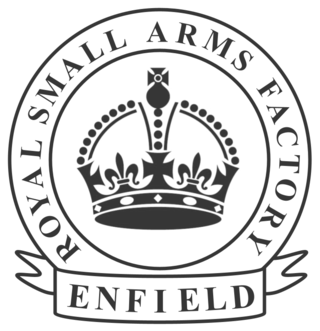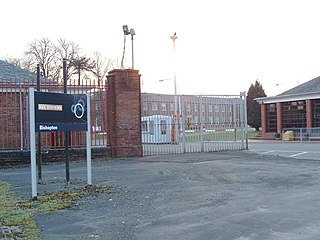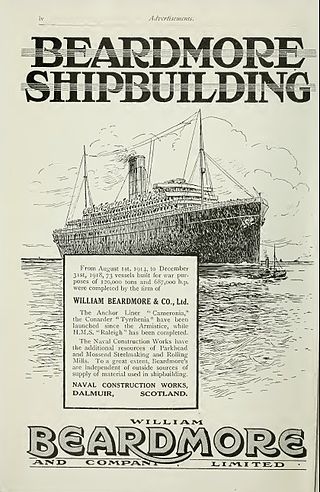Related Research Articles

Cordite is a family of smokeless propellants developed and produced in Britain since 1889 to replace black powder as a military firearm propellant. Like modern gunpowder, cordite is classified as a low explosive because of its slow burning rates and consequently low brisance. These produce a subsonic deflagration wave rather than the supersonic detonation wave produced by brisants, or high explosives. The hot gases produced by burning gunpowder or cordite generate sufficient pressure to propel a bullet or shell to its target, but not so quickly as to routinely destroy the barrel of the gun.

Royal Ordnance Factory (ROF) Bridgwater was a factory between the villages of Puriton and Woolavington in the Sedgemoor district of Somerset, England that produced high explosives for munitions. It was slightly above sea level, between the 5-and-10-metre contour lines on Ordnance Survey maps. BAE Systems closed it when decommissioning was completed in July 2008.

The Royal Arsenal, Woolwich is an establishment on the south bank of the River Thames in Woolwich in south-east London, England, that was used for the manufacture of armaments and ammunition, proofing, and explosives research for the British armed forces. It was originally known as the Woolwich Warren, having begun on land previously used as a domestic warren in the grounds of a mid-16th century Tudor house, Tower Place. Much of the initial history of the site is linked with that of the Office of Ordnance, which purchased the Warren in the late 17th century in order to expand an earlier base at Gun Wharf in Woolwich Dockyard.
ROF Glascoed was built as a UK government-owned, Royal Ordnance Factory (ROF). It was designed as one of 20 munitions filling factories. It was planned as a permanent ROF with the intention that, unlike some other similar facilities, it would remain open for production after the end of World War II. After privatisation of the Royal Ordnance Factories in the 1980s it became part of Royal Ordnance plc and later a production unit of BAE Systems.

The Royal Small Arms Factory (RSAF), also known by the metonym Enfield, was a UK government-owned rifle factory in Enfield, adjoining the Lee Navigation in the Lea Valley. Some parts were in Waltham Abbey. The factory produced British military rifles, muskets and swords from 1816. It closed in 1988, but some of its work was transferred to other sites.
An explosive ROF was a UK government-owned Royal Ordnance Factory (ROF), which specialised in manufacturing explosives during and after World War II. In World War I, the name used in the UK for government-owned explosives factories was National Explosives Factory; the cordite factory at Gretna was known as HM Factory, Gretna.

Royal Ordnance Factories (ROFs) were munitions factories run by the UK government during and after the Second World War. The three main types of factories were engineering, filling and explosives, and these were dispersed across the country for security reasons. ROFs were the responsibility of the Ministry of Supply and later the Ministry of Defence until privatisation in 1987.
ROF Thorp Arch was one of sixteen Second World War, UK government-owned Royal Ordnance Factory, which produced munitions by "filling" them. It was a medium-sized filling factory.
A filling factory was a manufacturing plant that specialised in filling various munitions, such as bombs, shells, cartridges, pyrotechnics, and screening smokes. In the United Kingdom, during both world wars of the 20th century, the majority of the employees were women.

The Royal Ordnance Factory (ROF) Bishopton was a WW2 Ministry of Supply Explosive Factory. It is sited adjacent to the village of Bishopton in Renfrewshire, Scotland. The factory was built to manufacture the propellant cordite for the British Army and the Royal Air Force. It also later produced cordite for the Royal Navy. The Ministry of Works were responsible for the site. It was the biggest munitions factory the MOD had, with up to 20,000 workers.

William Beardmore and Company was a British engineering and shipbuilding conglomerate based in Glasgow and the surrounding Clydeside area. It was active from 1886 to the mid-1930s and at its peak employed about 40,000 people. It was founded and owned by William Beardmore, later Lord Invernairn, after whom the Beardmore Glacier was named.
A World War I explosive factory, which was to be later known as NEF Pembrey was built, by Nobel's Explosives, with British Government approval, near the village of Pembrey, Carmarthenshire, Wales. The factory was built on a site consisting of mainly sandhills and sand dunes to provide some protection against damage caused by an explosion. Its main product was TNT (Trinitrotoluene) used for shell filling. The same site was used in World War II to build another explosive factory ROF Pembrey, which also made TNT.

Dalmuir is an area nine miles northwest of Glasgow, Scotland, on the western side of Clydebank, and part of West Dunbartonshire Council Area. The name is a lowland Scots derivation of the Gaelic meaning Big Field. The area was originally two separate villages with Dalmuir Shore joining with Clydebank in 1886 and Dalmuir Village in 1906, during a period of rapid industrialization and expansion. Dalmuir is bounded by the village of Old Kilpatrick to the west, the Mountblow and Parkhall housing schemes to the north, and the Clydebank town centre area to the east. To the south is the River Clyde.

ROF Chorley was a UK government-owned munitions filling Royal Ordnance Factory. It was planned as a permanent Royal Ordnance Factory with the intention that it, unlike some other similar facilities, would remain open for production after the end of World War II; and, together with ROF Bridgend, would replace the Royal Filling Factory located at the Royal Arsenal, Woolwich. It was built largely in Euxton, but was known as ROF Chorley.
ROF Patricroft was a Royal Ordnance Factory in Patricroft, near the town of Eccles, England.

Coventry Ordnance Works was a British manufacturer of heavy guns particularly naval artillery jointly owned by Cammell Laird & Co of Sheffield and Birkenhead, Fairfield Shipbuilding and Engineering Company of Govan, Glasgow and John Brown & Company of Clydebank and Sheffield. Its core operations were from a 60-acre site in Stoney Stanton Road in the English city of Coventry, Warwickshire.
Royal Ordnance Factory (ROF) Nottingham opened in 1936 in The Meadows, Nottingham, United Kingdom. It was one of a number of Royal Ordnance Factories created in the build up to World War II. During the war the site employed up to four thousand workers. The factory was closed in 2001.
Royal Ordnance Factory Newport, commonly known as ROF Newport, was a World War II munitions factory in Wales that produced guns. The factory began construction in 1940 and was completed within a year, producing its first weapons by January 1941. The site employed around 2,000 people during the war in the manufacture of anti-tank and anti-aircraft weapons; one of the main weapons built at the factory was the Bofors 40 mm gun.

The Golden Jubilee University National Hospital is a hospital in Clydebank, near Glasgow, Scotland. It was opened in 1994 and is managed by a Special Health Board appointed by NHS Scotland.
References
- Johnston, Ian, (1993). Beardmore Built: The Rise and Fall of a Clydeside Shipyard. Clydebank: Clydebank District Libraries & Museums Department. ISBN 0-906938-05-8.
- Hay, Ian, (1949). R.O.F: The story of the Royal Ordnance Factories. 1939 - 1945. London: HMSO.